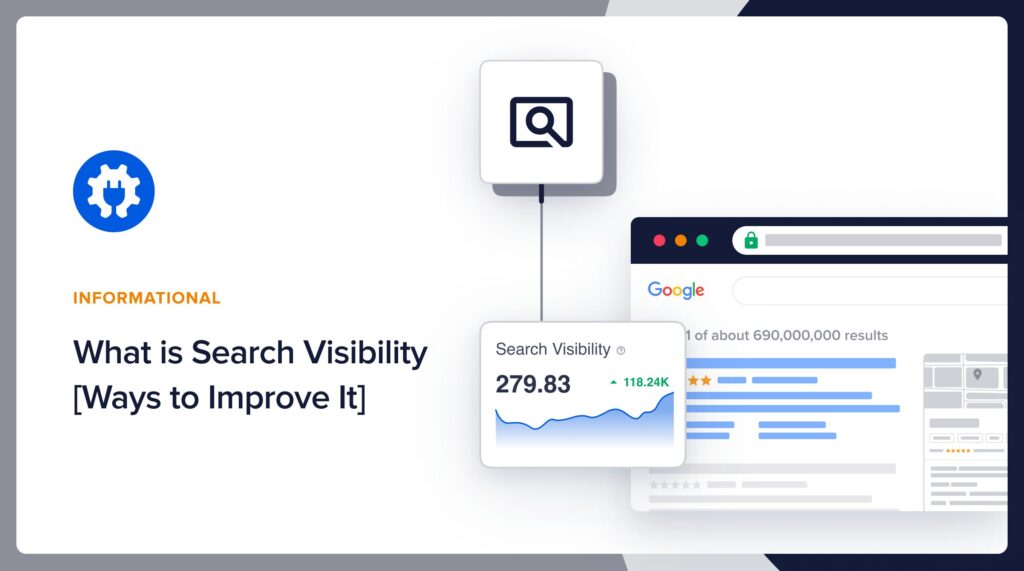What is search visibility?
You’ve probably heard the term as you navigate the world of search engine optimization (SEO) and digital marketing.
But what is it, and why does it matter?
In this article, we’ll define search visibility, why it matters, and how to improve yours.
In This Article
- What is Search Visibility in SEO?
- The Importance of Improving Your Search Visibility
- How Do You Check Search Visibility?
- Factors that Negatively Affect Search Visibility
- How to Improve Your Search Visibility in 7 Easy Ways
- Search Visibility: Your FAQs Answered
- Improve Your Search Visibility, Boost Your Organic Traffic
What is Search Visibility in SEO?
Search visibility refers to how your site (or a particular web page) is visible to users in organic search results. It’s a multifaceted concept going beyond merely ranking for specific keywords. Instead, it encompasses factors like organic traffic, user engagement, and overall online presence.
At its core, search visibility is about being discoverable by the right audience. It involves optimizing various elements of your site to ensure search engines recognize its relevance to users’ queries. It’s also about maintaining a consistent and prominent presence across various relevant search queries.
A high search visibility indicates that your site is ranking well and attracting organic traffic.
The Importance of Improving Your Search Visibility
Improving search visibility is crucial to an impactful online presence. Some reasons for this include:
Increased Organic Traffic
When a website ranks higher on search engine results pages, it is more likely to attract organic traffic. Higher website traffic not only means a greater reach but also increases the likelihood of converting visitors into customers.
Helps Establish Online Authority
Search visibility is a testament to a site’s authority within its niche. Consistently appearing in search results positions your site as a reliable source of information, fostering trust among users. As a result, you’ll be seen as an authority in your niche.
Improves Conversion Rates
Enhancing search visibility goes hand in hand with optimizing for conversions. If your site is easily discoverable and provides a seamless user experience, it’s more likely to convert visitors into customers or subscribers. This means you’ll enjoy a boost in your clickthrough rates.
As you can see, improving your search visibility isn’t something to put off. Especially if your website is a critical component of business growth and revenue generation, you must prioritize improving your search visibility.
How Do You Check Search Visibility?
There are many tools you can use to see how visible your posts or pages are in search results. However, if you’re a WordPress user, the best way to do that is by using All In One SEO (AIOSEO).

AIOSEO is a powerful yet easy-to-use SEO plugin that boasts over 3 million active installs. This means millions of smart bloggers use AIOSEO to help them boost their search engine rankings and drive qualified traffic to their blogs. That’s because the plugin has many powerful features and modules designed to help you properly configure your SEO settings.
For step-by-step instructions on how to install AIOSEO, check our detailed installation guide.
Regarding search visibility, one of the modules that can help you improve yours is the Search Statistics feature.
Using Search Statistics to Check Your Search Visibility
Search Statistics is a powerful Google Search Console integration that lets you track your keyword rankings and see important SEO metrics with 1-click. It comes with many reports for monitoring SEO performance.
Checking Search Visibility By Monitoring Your Overall SEO Metrics
Checking your search visibility in WordPress is a breeze. To do so, head over to Search Statistics in the AIOSEO menu. Clicking on this leads you to the Search Statistics Dashboard.
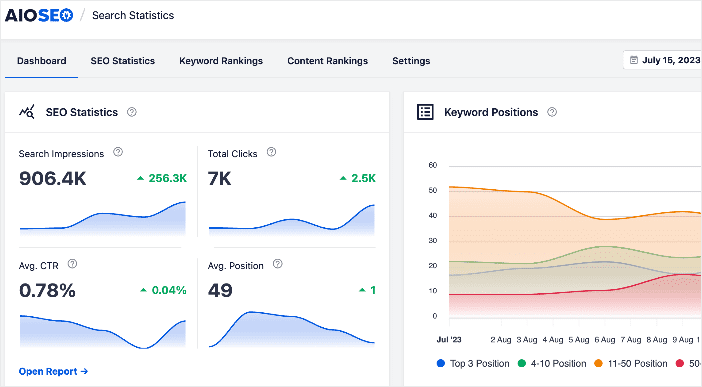
The Dashboard section will give you an overview of important SEO metrics like Search Impressions, Total Clicks, Average CTR, and Average Position. It also shows you an overview of the number of keywords ranking at different positions. You can see this in the Keyword Positions section.
The Search Impressions metric is the most important one when checking search visibility. That’s because it shows how many times your content was seen on search engine results pages (SERPs). The higher the impressions, the greater your search visibility.
Besides the overview on the dashboard, there are two other reports that can help you check your search visibility. These are the Keyword Ranking report and the Content Performance report.
Using the Keyword Rankings Report
The Keyword Rankings report gives you great insights into how you’re performing for your chosen keywords. You can check this by going to AIOSEO » Search Statistics » Keyword Rankings.
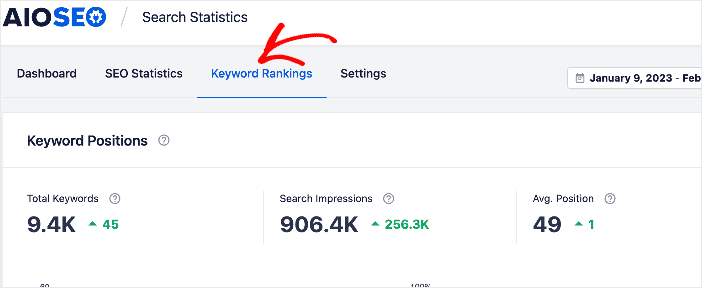
This is where you get a detailed report of all your keywords and their performance on SERPs. It shows you the Total Keywords you’re ranking for, Search Impressions, and Average Position. These metrics give you a general overview of your rankings and online reach.
They show how visible you are for all the keywords you’re trying for and how well your SEO efforts are paying off.
To get more granular, scroll down to the Keyword Performance section. This gives you a deeper look at how individual keywords are performing.

Essential metrics for each keyword include Clicks, Average CTR, Impressions, Position, and Diff.
Again, the impressions tab is the important one as it shows how visible you are on SERPs for that particular keyword.
Using the Content Performance Report
The Content Performance report is essential for checking how visible your content is on search engines. To access it, go to AIOSEO » Search Statistics » SEO Statistics. Next, scroll down to the Content Performance report.

The Content Performance report shows you 3 main content metrics, namely:
- Top Pages: This shows you your best-performing pages.
- Top Losing: This shows the pages losing rankings the most.
- Top Winning: This shows the content that’s gaining higher rankings.
The Content Performance report gives you key metrics like Clicks, Impressions, Position, and Diff (change in position) for each page in this report. These give you deep insights into what’s happening to your content on SERPs.
Regarding search visibility, the Top Winning content is bound to be more visible on SERPs, as is the content with greater Impressions.
Factors that Negatively Affect Search Visibility
Before we look at how you can improve your search visibility, let’s briefly troubleshoot some factors that can negatively affect it.
Algorithmic Changes
Search engines frequently update their algorithms. If your site doesn’t meet the requirements of the new updates, your rankings can tank. As a result, your search visibility will be negatively impacted. This is why staying abreast of and monitoring the impact of Google algorithm updates is an important SEO best practice.
Poor SEO Practices
Engaging in harmful SEO practices, such as keyword stuffing, cloaking, or using low-quality backlinks, can result in penalties from search engines. These penalties can significantly diminish search visibility.
So, avoid making these SEO mistakes at all costs.
Competitor Dominance
In highly competitive niches or industries, gaining search visibility involves outperforming competitors. Analyzing competitor strategies and differentiating one’s approach is crucial for overcoming this challenge. An excellent SEO hack you can use here is stealing your competitor’s keywords.
How to Improve Your Search Visibility in 7 Easy Ways
Ready to improve your search visibility?
Let’s dive into 7 easy ways to help you do that.
1. Conduct Proper Keyword Research
Proper keyword research is one of the most important elements in ensuring good search visibility. This involves identifying the words and phrases your target audience uses to find you online. You can use many tools for this, including Ahrefs, Semrush, and more.
If you’re in a competitive niche, you’ll have better success at targeting long-tail keywords as they have lower keyword difficulty but relatively high search volume.
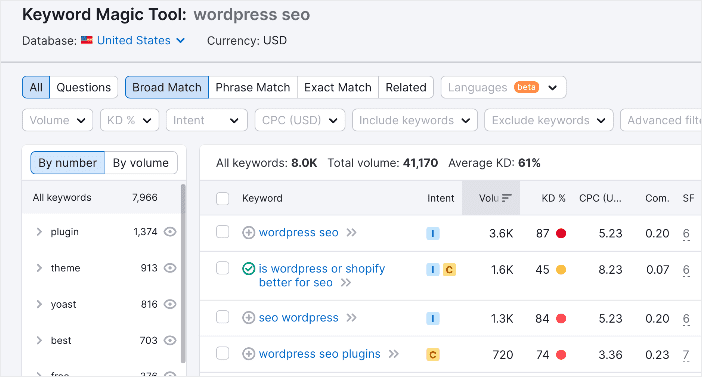
If you’re searching for a keyword research tool, check out our recommended keyword research tools here.
Finding relevant keywords for your content is a critical step to improving your search visibility. That’s why you must prioritize this step.
2. Create Helpful Content
Once you’ve found your target keywords, the next step to boosting your search visibility is creating helpful content around it. Helpful content is content your audience finds useful as it answers their questions and meets search intent. It must be high-quality content that serves your audience’s needs more than your business needs.
Content optimization should also play an essential role in creating helpful content. This means creating scannable content that is easy to read.
A great tool here would be AIOSEO’s TruSEO highlighter. This content optimization tool helps improve your readability scores and more.

Besides the TruSEO Highlighter, you can also use AIOSEO’s TruSEO On-page Analysis once you’re done writing your content.
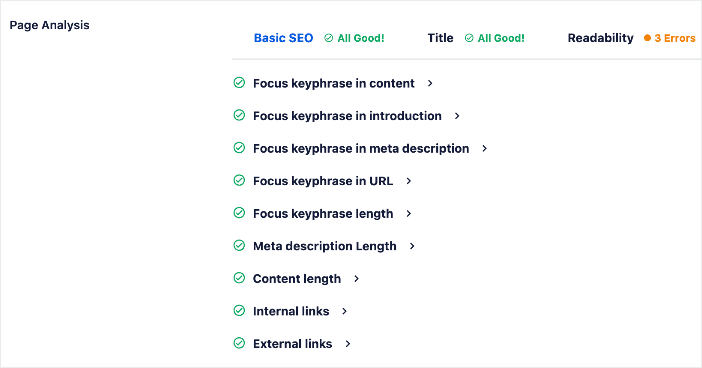
The TruSEO On-page Analysis gives you a score of how well-optimized your content is. It even gives you recommendations for improving your it.
Your content must provide value to your audience and must be easy to read.
3. Follow SEO Best Practices
Following SEO best practices is another way to ensure your search visibility is good and that you’re visible to the right audience. SEO best practices encompass a wide range of techniques and strategies you can use to optimize your site for better rankings and conversion rates. Here are some essential SEO best practices that should be non-negotiable:
Use the Right SEO Plugin
Using the right WordPress SEO plugin is an essential SEO best practice. And we’re proud to say AIOSEO is one of the best. Don’t just take our word for it. Check out real-life case studies here.
Don’t Neglect Metadata
Metadata in SEO refers to the information (HTML tags) that provides more details to search engines about the content on your posts or pages. There are several types of metadata with the 2 most important being SEO title tags and meta descriptions.
These require creativity and time to get right because you should stick to a stipulated character count while effectively conveying your message. Thankfully, you can use AI to generate SEO-friendly metadata, saving you lots of time while enhancing your SEO.
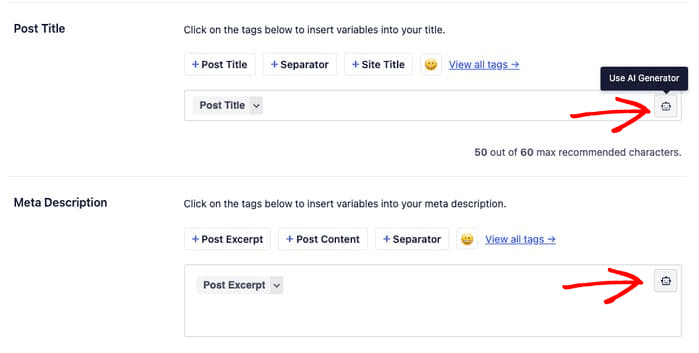
SEO-friendly URLs
A URL, or Uniform Resource Locator, is a reference or address used to access resources on the internet. It’s your webpage’s address, making it a critical element in boosting your search visibility.
To ensure your URLs are SEO-friendly, you should include the target keyword, keep them short, and avoid numbers, among other best practices. Check out our tutorial on the best permalink structure for more information.
Ensure Proper Indexing of Your Content
Your site and content will be invisible on the internet without proper indexing. Indexing is the process search engines use to analyze and store the information collected during the crawling process. The data is organized and added to Google’s index (or any other search engine) for easy retrieval when relevant searches are made.
Check out our tutorial on checking the index status of your content right inside your WordPress dashboard.
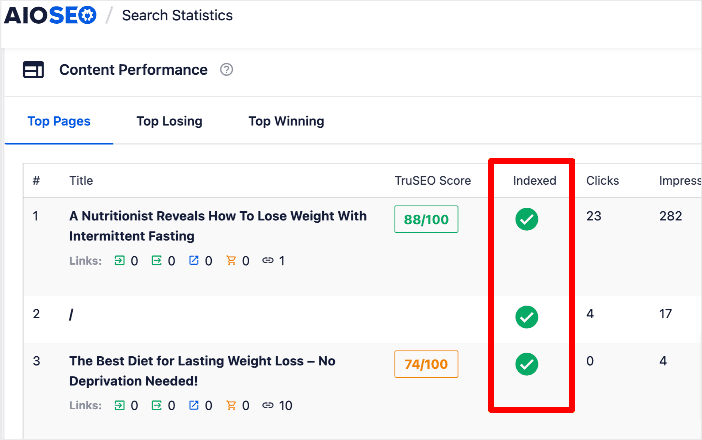
This powerful tool helps you know which content has been indexed. More importantly, it helps troubleshoot content that hasn’t been indexed yet.
4. Aim for the Featured Snippet
Another SEO hack to help boost your search visibility is optimizing your content to rank for position zero, or the featured snippet.
A featured snippet is a special type of search result displayed at the top of SERPs that provides users with a direct and concise answer to their query.
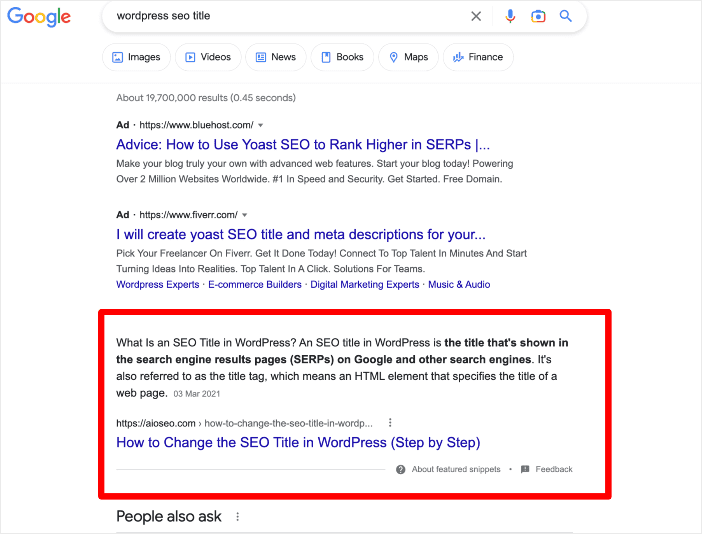
A few ways to land the featured snippet include:
- Implementing schema markup
- Using a table of contents
- Adding FAQs to your content
- Optimizing your content
- Creating the best piece of content on the topic
For tips on optimizing for this coveted piece of real estate on SERPs, check out our tutorial on getting the featured snippet.
5. Target Google’s People Also Ask (PAA) Section
Google’s People Also Ask (PAA) section refers to the SERP feature containing related questions searchers may have about your particular topic.
The PAA section of Google’s SERPs is a prominent feature that allows publishers to bolster their visibility on search engines further.
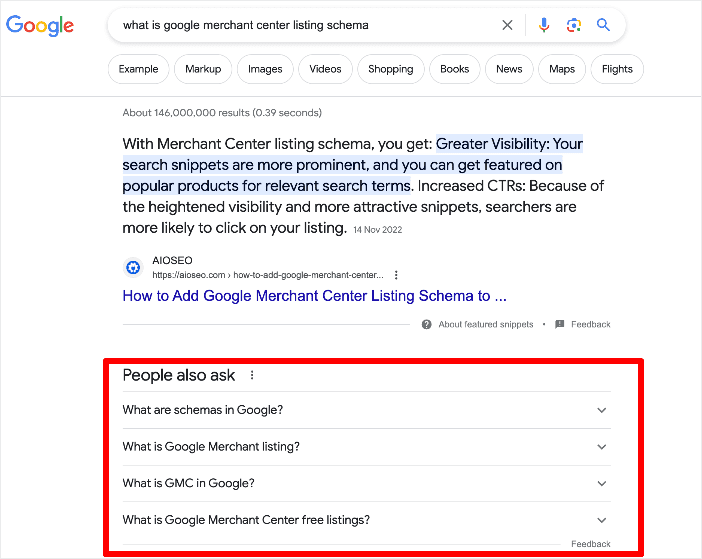
Optimizing for the PAA section also helps you bolster your semantic SEO strategy. This is because answering the common questions users ask concerning your primary keyword helps you create content with semantic depth. It also helps you capture traffic for long-tail keywords.
You can check out our guide to optimizing for Google’s people also ask section for step-by-step instructions.
6. Optimize Your Robots.txt File
A robots.txt file is a powerful SEO tool that instructs search engines on how to interact with your site. You can use it to disallow the crawling of certain URLs and prioritize pages to be crawled and indexed. You can even use it to instruct search engines when to crawl your site. This is why optimizing your robots.txt is essential to boosting your site’s visibility.
Here’s an example below of what a robots.txt file looks like:

You can easily optimize your robots.txt file using AIOSEO’s advanced Robots.txt Editor. To access it, go to your AIOSEO menu » Tools » Robots.txt editor.
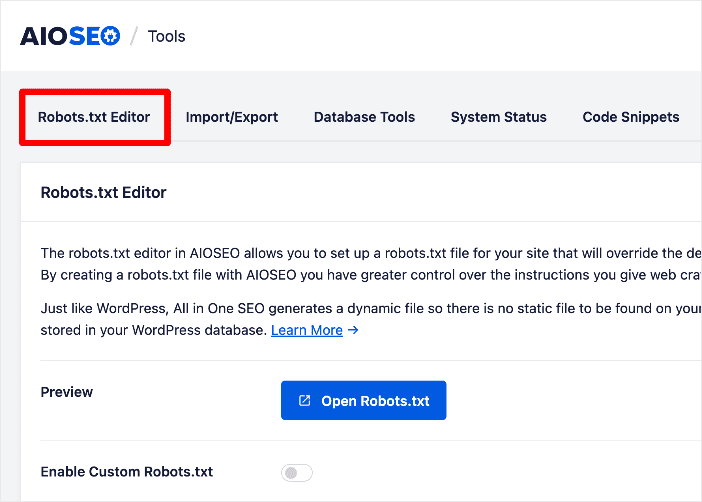
AIOSEO’s advanced Robots.txt Editor makes optimizing your robots.txt file easy. That’s because it has many useful directives or instructions for search bots. Examples of said directives include Allow, Disallow, Clean-param, and Crawl-delay.

AIOSEO’s robots.txt editor also allows you to import a robots.txt file from another site. This handy feature saves you a lot of time optimizing yours.
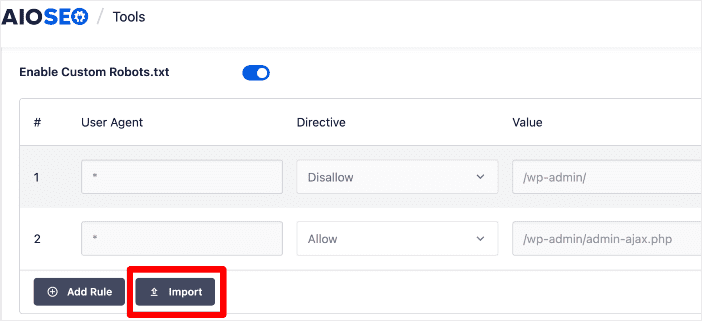
For more details, check out our tutorial on editing a robots.txt file in WordPress.
7. Monitor the Impact of Google Algorithm Updates
As said earlier, Google algorithm updates can sometimes hurt your search visibility. That’s why keeping an eye on their impact on your search rankings is important.
Thankfully, monitoring the impact of Google algorithm updates is easy with AIOSEO’s Search Statistics feature.
Once you’ve opened Search Statistics, the next step is to navigate to the SEO Statistics tab. Here, you’ll find a timeline showing your SEO performance. You’ll also find markers of major Google algorithm updates on the same timeline.
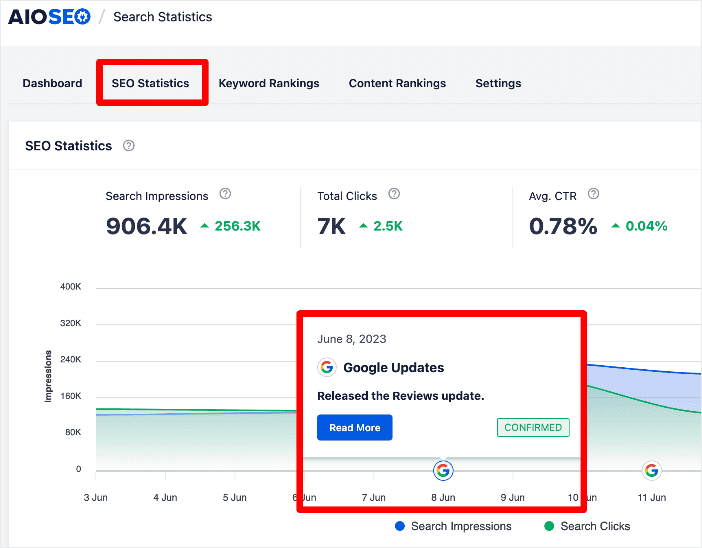
To check the impact of a Google algorithm update, compare the changes in your SEO performance with the date the update rolled out. Check if your content rose in rankings or took a dip in the days following an update.
You can also click on the Read More button to understand what that particular update requires for you to rank well.
Search Visibility: Your FAQs Answered
What is search visibility in SEO?
Search visibility in SEO refers to how easily a website or web page can be found by users when they enter relevant queries in search engines. It measures how prominently a site appears in search engine results pages (SERPs) for specific keywords or topics.
Why is search visibility important?
Search visibility is important because it directly impacts organic traffic to a website. The more visible a site is on SERPs, the more likely it is to get clicks and visitors. Improved search visibility also establishes online authority, builds brand credibility, and contributes to overall business success.
How do you check search visibility?
Checking search visibility involves using tools like Google Search Console (GSC). You can also check it right inside your WordPress dashboard using an SEO plugin like All In One SEO (AIOSEO).
Improve Your Search Visibility, Boost Your Organic Traffic
Search visibility is crucial if you’re to get positive results from your content marketing. After all, the more people see your content, the higher your chances of getting customers.
We hope this post has helped you understand search visibility and its impact on your site’s traffic. You may also want to check out other articles on our blog, like our beginners’ guide to SEO or our ultimate WordPress SEO checklist.
If you found this article helpful, then please subscribe to our YouTube Channel. You’ll find many more helpful tutorials there. You can also follow us on X (Twitter), LinkedIn, or Facebook to stay in the loop.
Disclosure: Our content is reader-supported. This means if you click on some of our links, then we may earn a commission. We only recommend products that we believe will add value to our readers.
